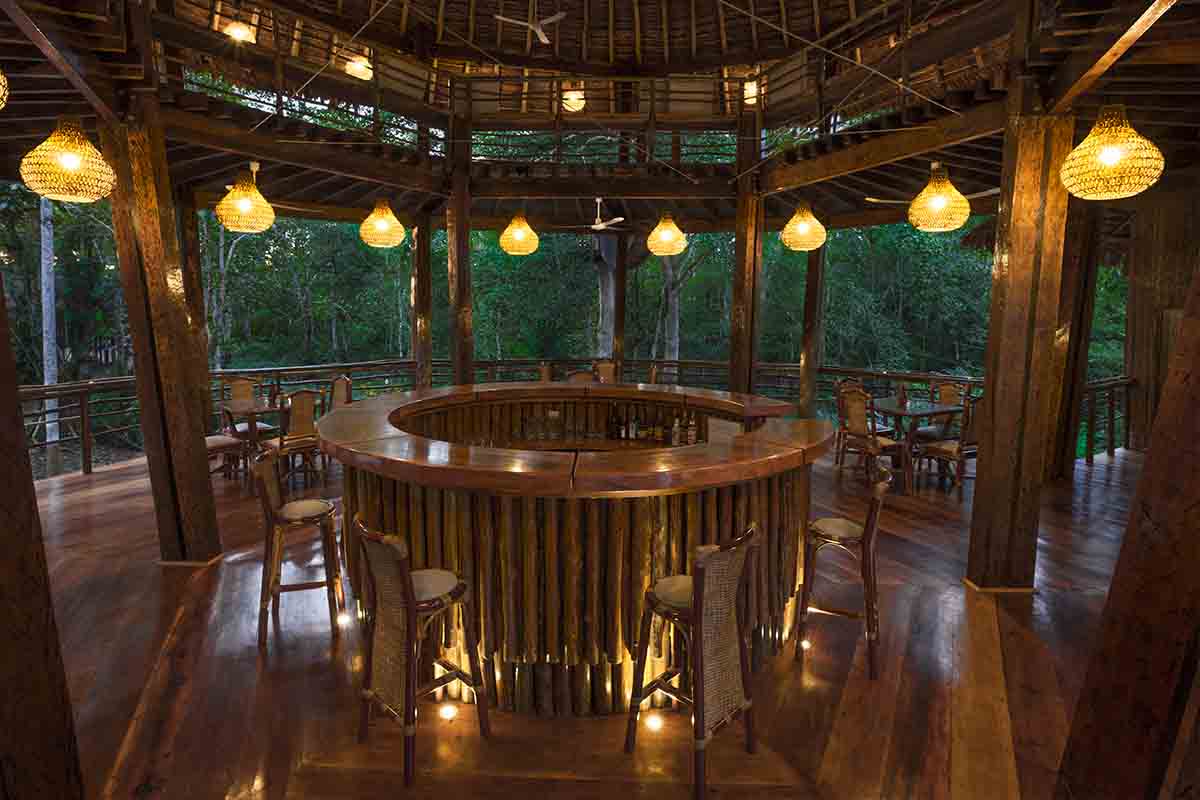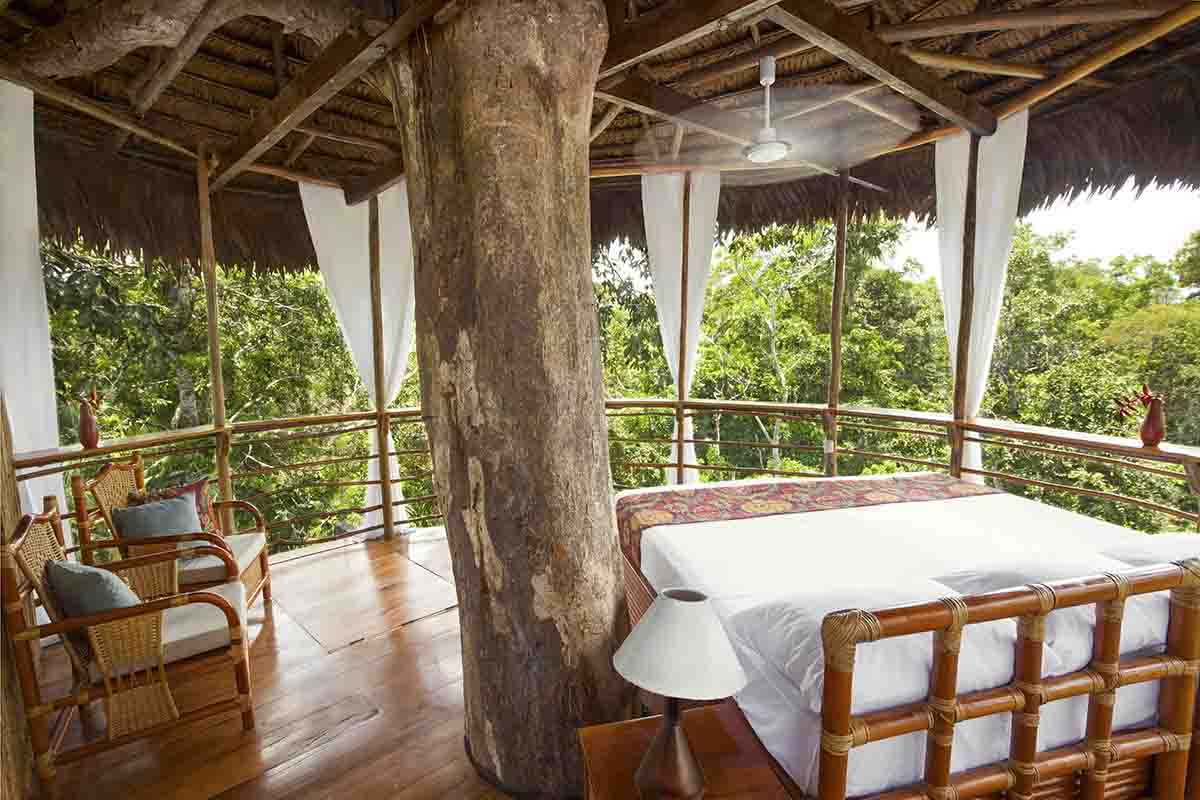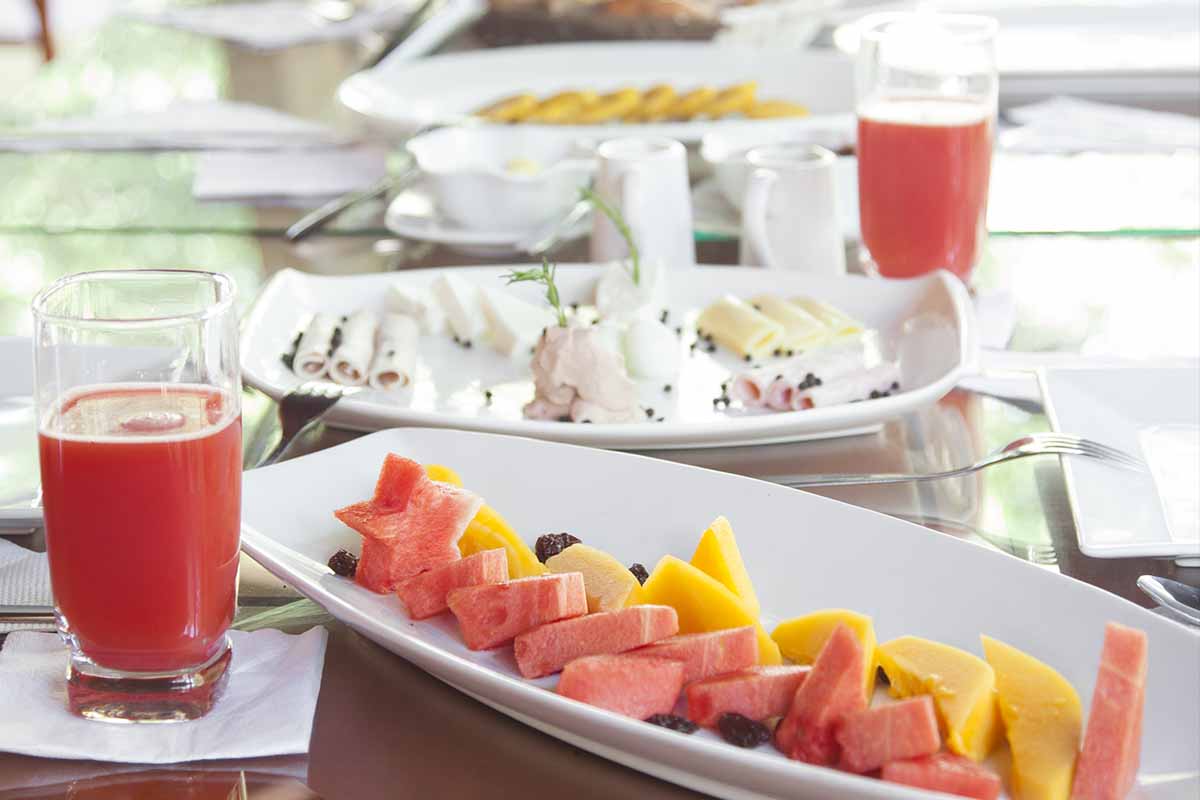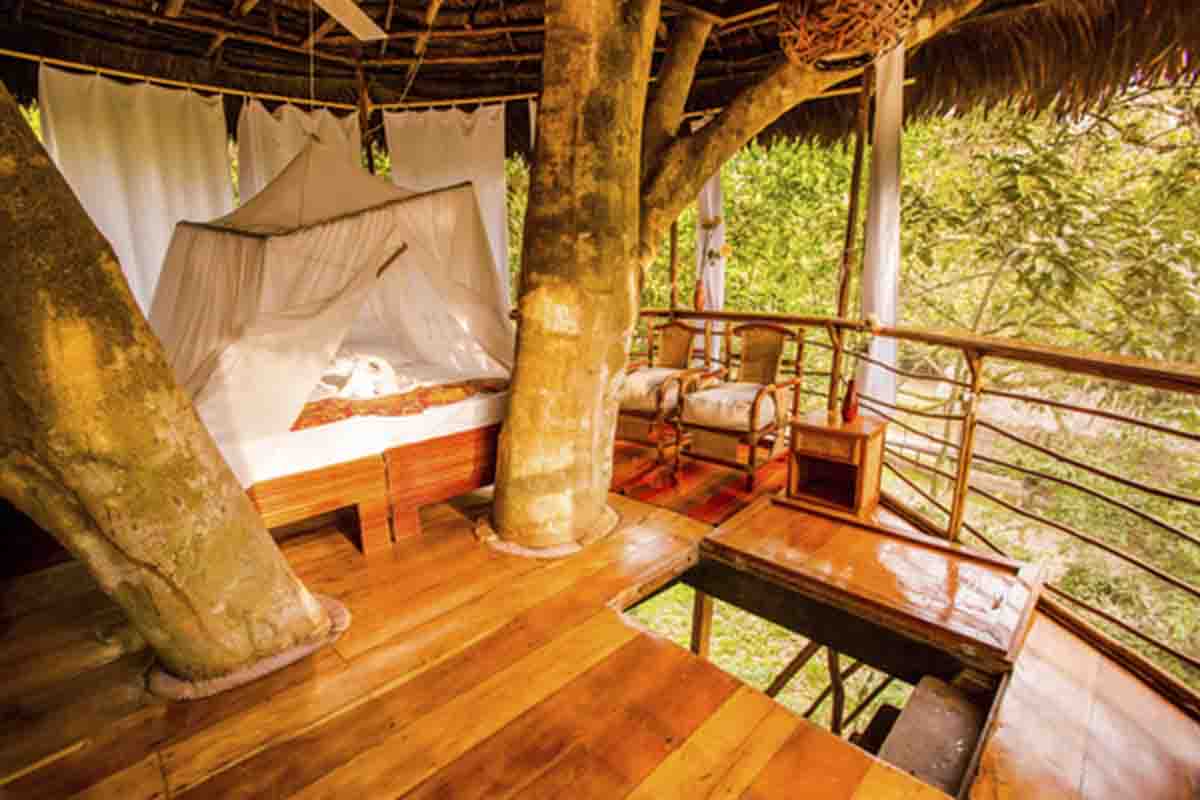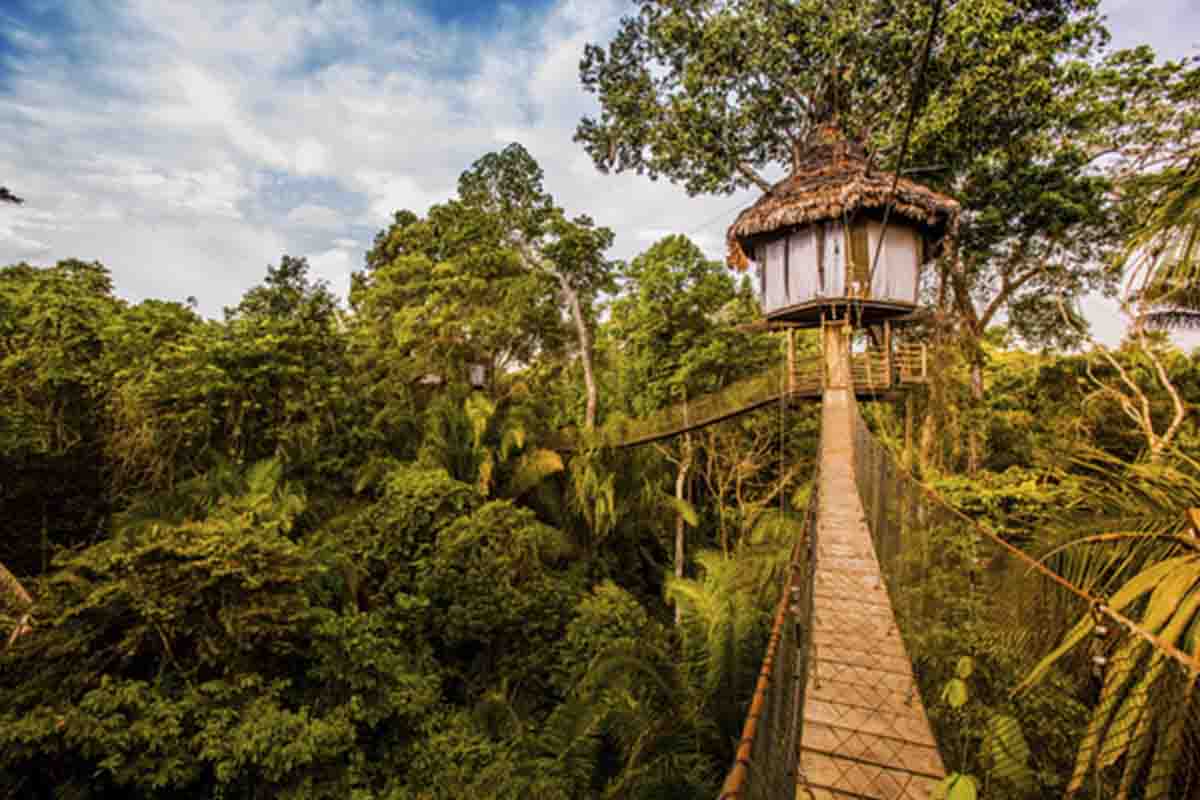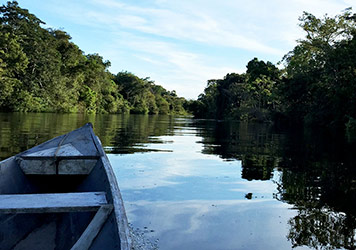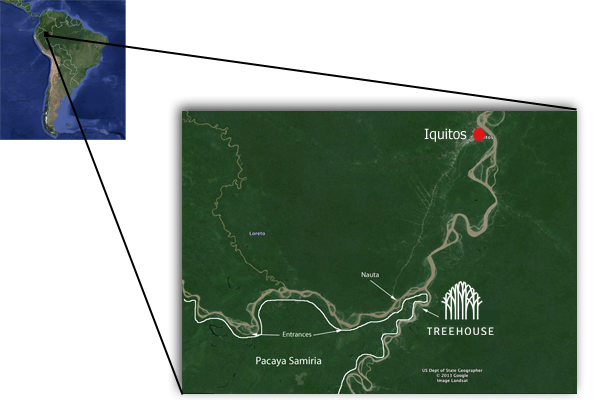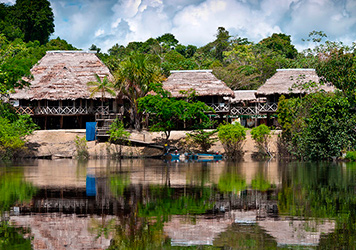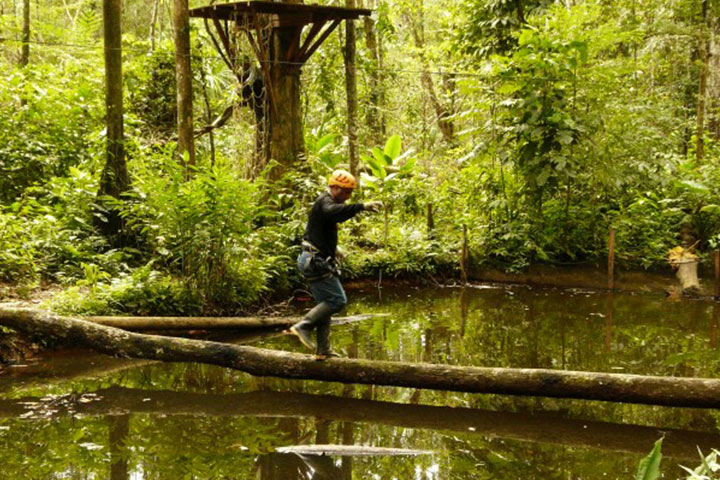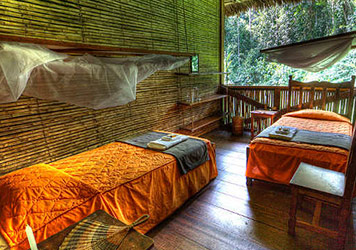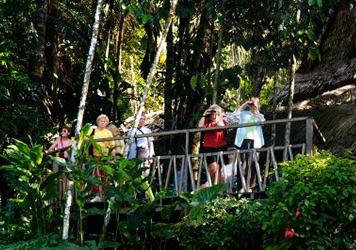Common Area
From the minute you get off the boat and begin your walk along the grand serpentine entrance, you will sense the uniqueness of this jungle lodge experience. Depending on the water levels, the entrance will carry you over a lagoon or the jungle floor to the heart of Treehouse Lodge’s 345 acre pristine jungle preserve.
Treehouse Lodge was designed to give it’s guests the best views of the rainforest and its native animal life. Every treehouse has a lower public platform and an upper private platform where you will stay. All guests are welcome to explore the lodge and rainforest canopy from all of the lower platforms connected by bridges.
Food
Treehouse Lodge provides guests with 3 quality meals per day. Every meal is served in our main lodge protected from the insects and elements. When your excursion takes you away from the lodge during meal time, a packaged meal will be provided. Our world-class chef creates tasty and beautiful meals made from a combination of chicken, beef, fish, and vegetables prepared Peruvian style. Trust us, the food will exceed your expectations – especially for a restaurant in the middle of the jungle! Please let us know if you have any dietary restrictions and we will do everything we can to adapt to your needs.
Our kitchen is equipped with commercial, stainless steel appliances and facilities, refrigerator, and freezer. The dining area is furnished with comfortable chairs and tables, fully enclosed in mosquito mesh, with ceiling fans above to keep you cool. For your enjoyment, there is a beautiful circular bar in the middle of the lower floor. Though beverages from the bar are extra, all water and juice is included in your price. Purified water is shipped into the lodge for your health and safety.
Safety
At Treehouse Lodge, guests sleep in actual treehouses, not mere treehouses propped up on stilts in the midst of trees. To achieve this ambitious vision, we took every precaution to ensure the safety of both our guests and the trees. The main lodge, treehouses, cable bridges and stairs were engineered in the United States by a structural engineer. The treehouses are supported by connections to the tree, suspension from the branches above, and multiple steel cables to the ground. Annual inspections and adjustments are made to maintain the safety of the lodge.
Tree platforms and bridges are all built with wooden railings and, in some cases, steel cables. Bridges are equipped with foot and hand cables connected by vertical cable supports. Strong webbing is installed on the side walls of the bridges to ensure your comfort and safety. The main lodge and all treehouses are enclosed with mosquito mesh and, just to help you sleep a little better, an extra layer of mosquito mesh is placed over your bed and tucked underneath your mattress.
We invite you to come to the jungle and see animal life, but on your terms. All of your movement through the lodge will be on raised wooden platforms or cable bridges to keep you safe from the wildlife on the jungle floor. Any walking in the jungle will be done with an experienced guide.
At Treehouse Lodge, we bring in fresh, purified water for drinking and cooking to ensure the health of our guests. Most of the water used at Treehouse Lodge comes from the river. We have a 4-tank water purification system that provides water for showers, toilets, sinks, and cleaning. The first tank allows the sediment to settle. The second two tanks are for purification. The final tank sits atop a high tower for pressure. Additionally, every treehouse has it’s own purified water tank for showers, toilets, and sinks.
Eco-friendly
Our goal was to build a lodge which allowed our guests to live among the animals and view the forest up close. Our hope is that every guest will return home with an increased appreciation for and commitment to the preservation of the Amazon rainforest. Treehouse Lodge was built by hand, with no heavy equipment, careful to leave the most minimal footprint possible. Every effort was made to preserve every tree and plant on the property.
At Treehouse Lodge, we bring in fresh, purified water for drinking and cooking to ensure the health of our guests. Most of the water used at Treehouse comes from the river. We have a 4-tank water purification system that provides water for showers, toilets, sinks, and cleaning. The first tank allows the sediment to settle. The second two tanks are for purification. The final tank sits atop a high tower for pressure. Additionally, every treehouse has its own purified water tank for showers, toilets, and sinks.
Activities
1) Dolphin Watching dophin watching in peru amazon
Dolphins are considered magical among the native Peruvians. According to local legend, dolphins would transform into humans and kidnap beautiful women from the communities and take them to their kingdom under the Amazon river. No need to fear, the dolphins we meet will do no such thing. Though dolphins are spotted all year round on the Amazon, there are specific feeding areas that our guides have designated along the Ucayali where visitors can swim and interact with the dolphins. You will boat along the river for approx 45 Min. If you’re feeling courageous, you can jump in and experience the joy of swimming with these beautiful and powerful creatures! Navigating along the Ucayali River you will also have the opportunity to observe other types of wildlife such as sloths, monkeys, and iguanas basking in the sun as well as many species of birds that feed on the fruits of trees that grow along the edges of the River.
2) Jungle Walk to Learn About Medicinal Plants Jungle Walk in Peru
The rainforest is like a green pharmacy where you can find many plants used to treat different diseases. You can find forest medicines for headaches, stomachaches, broken bones, hernias, and rheumatism – even for diabetes. On this Amazon Jungle excursion, you will explore through this greenery in search for some medicines found in each plant or tree, learning the secrets of the jungle and the relationship between plant and man; all the while bringing you closer to Mother Nature, protector of all the living organisms on our planet earth. The Amazonian people are the preservers of knowledge passed from one generation to another. Before cutting a plant in preparation for extracting medicine, many medicine men ask permission of the protector of the forest; if they don´t ask permission the medicine doesn’t work. This ancient belief is responsible for keeping the superpower natural forces in harmony.
3) Dugout Canoe Trip Canoe Trip Amazon River
For centuries, River people have moved along the Amazonian rivers on dugout canoes. Even today, this mode of transportation is the best way to explore the creeks: navigating slow, listening to the sounds of the jungle, and observing nature, attempting to imitate the exact way ribereño people see the forest. If you are a bird watcher from the canoes, you can observe and take pictures of many species of birds that feed and make nests close to the river shores. Many species of primates such as brown capuchins, squirrel monkeys, and saddle backed tamarins are easy to spot. You may even be able to observe rare and elusive creatures such as the river otters from the dugout canoes. At some point we will stop and fish for piranha! We will carry aboard wooden poles, with string and meat. When the piranha bites, you lift up the pole and voila. Not to worry, we will retrieve the fish for you.
4) Jungle Walk to Oxbow Lagoon to See the Giant Water Lilies and the Hoatzins water lilies
Participate on a fascinating jungle walk to this isolated lagoon that was once part of the river many years ago. The Oxbow Lagoon hosts many species of aquatic plants such as the giant water lilies that can grow to 6 ft. in diameter with flowers the size of cabbage. You will also observe the strangely interesting hoatzin, a bird feeds exclusively on poisonous plants that it can keep in its crop for several hours. Another species of bird you will find on this amazon jungle walk is the horned screamer that is related to the geese family and feeds on water lettuce and water hyacinth. Lastly, though perhaps most fascinating, you will be able to spot the wattled jacana, nick-named Jesus Christ because it can walk on water. These are just a few of the many animals that live into this varzea forest.
Jungle Walk to Oxbow Lagoon to See the Giant Water Lilies and the Hoatzins
5) Jungle Walk to observe the Night Monkey Night Monkey
Join this jungle walk to witness the only nocturnal monkey that can be spotted during the daytime. These primates make their homes in tree holes and, once located, can be seen sticking their heads out to take a peek. You will walk along a trail that runs close to an old tree where these night monkeys can be seen. They have a good sense of hearing, are very curious, and apparently evolved into nocturnal animals in order to avoid competition over food.
Jungle Walk to observe the Night Monkey
6) Visit the Jibaro Community jibaro community
Due to conflicts and tribal disputes that happened many years ago, a group of Jibaro people decided to move from their ancestral land located on the Pastaza river to an area closer to the equatorial border. They navigated downstream, following the Marañon river, then travelled along the Amazon to finally arrive at the Tahuayo river – a small, blackwater tributary where they created their community anew in peace, away from other villages, preserving their traditions and the knowledge of the ethnolinguistic group. You will take a boat from Treehouse Lodge downstream on the Yarapa River for 30 minutes to reach a community called Jaldar. From this village, you will walk 40 minutes on a jungle trail to arrive at the Jerusalem Jibaro community on the Tahuayo River. You will have a chance to learn the art of fishing in the Jibaro style as well as explore the Tahuayo river on dugout canoes to search Amazonian animals such as monkeys, macaws, toucans and sloths. You will also find out how they make their dugout canoes, how they prepare masato (a jungle beer made out of manioc), and how they make real blow darts, bows, and arrows still used in fishing and hunting today. While there, you will see original hand crafts made by girls of the community. These crafts will be available for purchase to take home as souvenirs. Before leaving, you will enjoy a picnic lunch at the chief’s house – our way of thanking him for his hospitality.
Visit the Jibaro Community
7) Night Excursion by Boat night excursion on amazon
If you enjoy the river by day, just imagine the life that awakens at night. On our night excursion, you will travel along the river, looking for wildlife with flashlights. The chances of spotting wildlife are good. You will see creatures like beautifully colored frogs resting on the floating plants on the edges of the creeks. You will see fishing bats that catch their prey using their talons like hawks, detected by sophisticated sonar. By the light of your flashlight, you will see potoos, owls, and caimans (located through their red eyes) that venture through the dark to catch their prey. At night you will also find creatures such as kinkajoos that feed on fruits and berries. They are easy to see while jumping from branch to branch on trees along the river. Even the opossum that feeds on birds can be spotted primarily at night. These are just a few of the many creatures that love to come out at night.
Night Excursion by Boat
8) Night Walk to see Insects frog in the amazon
Night time is a prime time for feeding. Once the sun sets, many creatures come out, some are the predators and others the prey. On this night excursion, you will see exotic beetles (rhinoceros and elephant species) and moths (sphinx and roschildia species). You will also find some lizards sleeping on the leaves. On our walk, you can see diverse species of frogs like the famous owl frog that makes holes in the ground and weighs over ½ pound. Amazonian people use the skin of this interesting anuran to make drums, but the owl frog protects itself from its predator by releasing a milky liquid from its skin. There is also a frog called gladiator tree frog that makes its nest close to the water to keep it from potential rivals and attract females for mating. At some point on the walk we will ask you to turn off your flashlight and stay quiet to let your senses adapt to the darkness, listening to the sounds of the rainforest in order to identify what they are and where they come from. At this moment, you will truly be able to appreciate the vastness of the Amazon Jungle with all its countless secrets.
Frog
9) Early Bird Watching from the Platforms bird watching in the amazon
The best way to witness wildlife is by waking up early to the sound of hundreds of birds and monkeys. The suspension bridges are built to bring you closer to all the wildlife that exists around Treehouse Lodge. You will see many species of tanagers, toucans, parrots, parakeets, antbirds, antwrens, woodpeckers, and monkeys that come to feed on the fruit and insects found on the trees. There are species of birds that never venture closer to the ground because the fruit they eat is found on the tree tops. Being closer to the canopy, it’s easy to see the beauty of these species. In only one early morning, you will observe at least 50 species of birds, 20 of which are uncommon. The variety of wildlife in this type of igapo forest is outstanding. The more appreciation we can gain of these species and the more research we can perform to find new species, the more likely they are to be preserved for future generations.
Early Bird Watching from the Platforms
10) Visit to Puerto Miguel, a Kukama Community village girl
If you’re looking for a way to truly experience the Peruvian natives, this is it. Visit Puerto Miguel and interact with the river people who still preserve their traditions, ancient knowledge, and even language. We will get to explore their homes made out of wood and palm trees to see how they live, what they cook, and the way they survive using the natural resources of the rainforest. You’ll find it fascinating to see how they have adapted to coexist with their environment, sharing their space with countless insects, dangerous animals and poisonous plants that can be used to kill or cure depending on preparation. The river people are skillful craft makers and have a communal house where you have the chance to purchase their beautifully hand-crafted items made using materials found in the Amazon jungle.
Visit to Puerto Miguel, a Kukama Community
11) Visit the Butterfly Farm butterfly amazon peru
Peru hosts close to 4,000 species of butterfly, more than any other place in the world. Many of the species are endemic and, therefore, restricted to Peru. The community of Vista Alegre, together with a Peruvian NGO, took measures to reproduce and protect some species of butterfly by creating a butterfly farm where farm villagers learn about the entire process of metamorphosis of these beautiful creatures. School children are especially interested in participating along with their parents in this educational project. As many butterflies are born every day on this farm, you will have the opportunity to release them into nature, contributing to the repopulation of butterfly species and the maintaining of environmental equilibrium.


